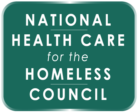Research: Community Health Workers (CHWs)
Supervision of CHWs
A Resource Guide for HCH Programs
Supervision is Key
Listen to the recording:
The most important factor in a CHW’s success within the HCH clinic and with clients is the presence of a consistent and supportive supervisor.
Supervisors need to have an understanding of the realities of a CHW’s day-to-day job. CHWs work very closely with clients on a variety of issues but they are not professional clinicians. It’s important for supervisors to check in with CHWs regularly to ensure they are not taking on too much responsibility and emotional weight. Consistent supervision should also: help CHWs develop healthy boundaries with clients and cultivate problem solving strategies, identify issues before they become larger problems, and identify education gaps and training needs.
CHWs integrated into clinical care teams should also have some level of clinical supervision to ensure the CHW is engaged in care planning, providing appropriate support in helping clients meet the goals in their care plans, and referring clients to clinic providers when necessary.
Qualities of an effective supervisor[ii]
- Clear understanding of the roles and responsibilities of the CHW
- Patience and accessibility
- Attentiveness to CHW’s personal and professional needs
- Willingness to assist with problem solving and encouraging of questions
- Readiness to advocate for the CHW within the larger organization
PROJECT SPOTLIGHT
Supervisors need to be sensitive to the ways in which the CHW’s lived experience of homelessness may affect their perceptions of themselves and their work.
For example, the catalyst for someone’s homelessness may have been the loss of a job and this fear may affect how they respond to constructive criticism. One CHW struggled with anxiety about the possibility of losing his job so much that any criticism from his supervisor was taken as a sign he would soon be fired.
His supervisor learned this about him early in the process, and changed her style of supervision where she reinforced his strengths and always reassured him he was doing a good job, even as she provided constructive feedback.
Self-Care
Working with vulnerable populations carries with it a high risk of burn out and compassion fatigue.[iii] CHWs work with clients who have experienced unimaginable trauma, loss, and pain.
Many struggle with untreated mental illness, addiction, as well as chronic diseases and acute illnesses. Bearing witness to the suffering of others takes a toll on people both personally and professionally.[iv]
Furthermore, the added toll of working within broken and fragmented health care and housing systems can accelerate fatigue and burnout.
Listen to the recording:
Self-care is critical to the work of CHWs. In addition to working with vulnerable populations, CHWs who have previous lived experience with homelessness may still struggle with different aspects of that experience. Someone may no longer be homeless but may still be struggling to maintain housing, maintain sobriety, pay bills, etc. It is the responsibility of the supervisor to ensure the CHW is able to engage effectively with clients while also managing their own life stresses.
Meeting regularly with CHWs helps supervisors monitor self-care concerns. One of the first signs of compassion fatigue and vicarious trauma is chronic exhaustion. If a supervisor notices this happening with a CHW it may be helpful to suggest a day off for some immediate relief but concerns should be addressed more fully as soon as possible. Ongoing feelings of exhaustion at work will eventually result in cynicism and resentment.[v] Additional signs of compassion fatigue and vicarious trauma may include:
- Feelings of helplessness and hopelessness
- Sense of persecution
- Diminished creativity
- Inability to grasp complexity
- Anger
- Decreased personal care (i.e. lack of sleep, poor hygiene, poor diet etc.)
PROJECT SPOTLIGHT
During monthly conference calls the CHWs participating in the National HCH Council’s project discussed challenges with clients and asked for strategies or recommendations from the other CHWs on how to address these issues.
Common challenges faced included clients relapsing into alcohol or drug use, clients lashing out at CHWs for issues beyond the CHW’s control, clients suffering from debilitating depression, frustrating and confusing client behavior, and delays and roadblocks for clients created by other organizations.
A tragic reality of working with such a vulnerable and often very sick population is, regardless of the efforts of the CHWs or HCH clinics, some clients’ health status will not improve. Fourteen clients enrolled in the National HCH Council’s project died during the project period.
The causes of death ranged from terminal illness and sudden health events to accidents and homicide. The trauma and grief of losing a client not only takes its toll on CHWs but it also affects their work with others. It can have an impact on the CHW’s ability to empathize with, understand, and support clients.[vi] It is vitally important for CHWs and their supervisors to have the tools to recognize the signs of burnout, and the strategies to address it.
Self-care should be a priority for all CHWs and should be monitored by their supervisors. If self-care is not prioritized and CHWs do not get the adequate support, their work and physical and emotional health may be negatively affected. Maintaining consistent, open, and honest dialogue with and between the CHWs helps supervisors address concerns of compassion fatigue and burnout.
Peer Supervision
The concept of peer supervision is becoming a more popular concept among organizations who employ CHWs. CHWs who are well-established within an organization are uniquely positioned to have a better understanding of what other CHWs experience in their work at an HCH.
Peer supervision capitalizes on a shared understanding and provides an increased opportunity for support through joint problem solving and skill development. CHWs who participate in peer supervision, in addition to traditional supervision, may feel a greater sense of peer support, develop a stronger commitment to implementing health activities, and find more creative solutions to problems[vii].
While peer supervision can create opportunities for CHWs to challenge one another and help each other recognize areas of needed growth, it is unhelpful and even damaging if peer supervision creates tensions. [viii]
Section 6 will explore how to integrate and support Care Teams and supportive environments when working with CHWs as well ass plenty of additional resources.
References
[i] Crigler, L., L. Gergen, and H. Perry. (September 2013). Supervision of Community Health Workers. Retrieved from: http://www.mchip.net/sites/default/files/mchipfiles/09_CHW_Supervision.pdf
[iii] Portoghese, I., M. Galletta, R.C. Coppola, G. Finco, and M. Campagna. (2014). Burnout and Workload Among Health Care Workers: The Moderating Role of Job Control. Journal of Safety and Health at Work, 5(3). Retrieved from: http://www.ncbi.nlm.nih.gov/pmc/articles/PMC4213899/
[iv] Van Dernoot Lipsky, L. (2009). Trauma Stewardship: An Everyday Guide to Caring for Self While Caring for Others. Berrett-Koehler Publishers Inc.: San Francisco, CA.
[v] Portoghese, I., M. Galletta, R.C. Coppola, G. Finco, and M. Campagna. (2014). Burnout and Workload Among Health Care Workers: The Moderating Role of Job Control. Journal of Safety and Health at Work, 5(3). Retrieved from: http://www.ncbi.nlm.nih.gov/pmc/articles/PMC4213899/
[vi] Van Dernoot Lipsky, L. (2009). Trauma Stewardship: An Everyday Guide to Caring for Self While Caring for Others. Berrett-Koehler Publishers Inc.: San Francisco, CA.
[vii] Crigler, L., L. Gergen, and H. Perry. (September 2013). Supervision of Community Health Workers. Retrieved from: http://www.mchip.net/sites/default/files/mchipfiles/09_CHW_Supervision.pdf
[viii][viii] Vu, H. (July 2014). Supervision of Community Health Workers in Low and Middle Income Countries. Retrieved from: http://peersforprogress.org/pfp_blog/supervision-of-community-health-workers-in-low-and-middle-income-countries

